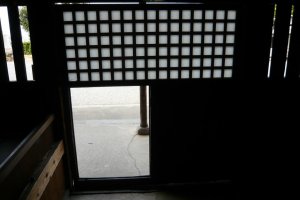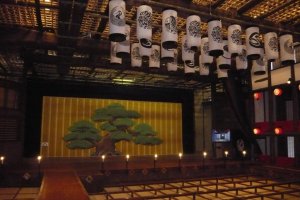Located in the lovely town of Kotohira sits the oldest operating Kabuki theater in Japan. The theater was built in 1835 and was quite popular during the middle of the Edo period. The theater was built to imitate the Onishi-Shibai (later Naniwa-za), one of the three theaters in Osaka at that time. The name of this theater changed each time it changed owners. It became the Kanamaru-za in 1990.
In 1970 the theater was designated as a Property of National Cultural Importance. In 1972, the theater was relocated to its present location. The move took four years to complete. Its former site is home to the Kotohira Folk History Museum.
Since 1985, a show called the Shikoku Kompira Kabuki Oshibai has been performed at Kanamaru-za and it's very popular in the spring. It's said that even locals have difficulty getting tickets to Kabuki performances.
The theater is completely original. It has no electricity inside. It offers performances only during the daytime as it's lit inside by candles and lanterns. Lighting is controlled by shades and blinds as well.
The theater features all the elements of a traditional Kabuki theater.
- Elevated walkway –This runs from the back of the theater to the left of the stage through the seating area.
- Trapdoor – Located on the walkway near the stage. This stealthy entrance is where ninjas, ghosts and other actors rise up during performances.
- Sliding lift – The kakesuji is a lift that takes the actor over the walkway to perform in mid-air.
- Human powered revolving stage – A round board (7.3 meters in diameter) located in the center of the stage, which is rotated from below by burly stage hands.
- Stage elevator – Off the revolving stage. An actor can be lifted from the trap cellar onto the stage.
- Illumination windows – The windows are used to darken or lighten the theater during the performance.
- Paper lanterns – During performances, the lanterns show the ranking of the actors.
- Grapevine trellis – A ceiling formed by 500 sticks of bamboo in a grid pattern, the trellis can be used to scatter confetti into the theater.
- Cellar – The space below the floor of the stage and elevated walkway is used to operate the revolving stage and for raising and lowering actors from the trapdoor. This is all done manually.
Walking tours of the theater are available and they offer a glimpse into the Edo era. The tour guide is quite informative and helpful. After the tour, you can walk around the theater on your own. It's amazing to see the dressing rooms, the private bath and even a walk down the narrow steps to the cellar is fascinating. If you go to Kotohira, I recommend a visit to Japan’s oldest working Kabuki Theater, Kanamaru-zu.


































